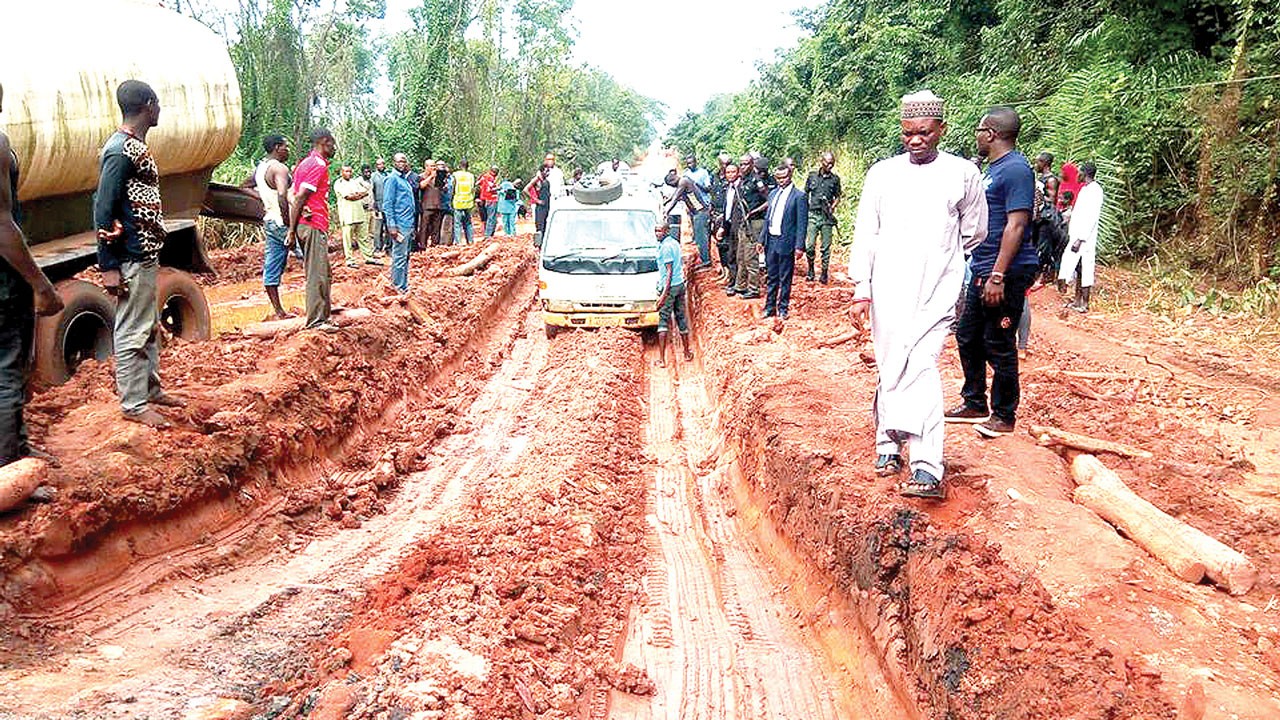Cover Story
Nigeria’s highways of deaths

By AYOOLA OLAOLUWA

A failed portion of Benin-Ekpoma-Auchi Road in Edo State
Travelling from one part of the country to another has become a misadventure that many Nigerians now dread venturing into. This is so because the bold ones who ply the roads go through hell before arriving at their destinations, with many bemoaning the terrible experiences they encounter on federal roads scattered across the country.
Business Hallmark investigation shows that virtually all the roads which transverse the breadth and length of the country are in deplorable conditions and require urgent rehabilitation.
Over 80 per cent of the roads from the Southern part of the country to the Northern part have become impassable for vehicles, with worst hit been the South-East and South-South roads.
Several trips on the roads to ascertain their worthiness revealed that large portions of the roads have collapsed and motorists who use them do so at their own peril.
From the Lagos-Abeokuta, Ikorodu-Ijebu-Ode, Ikorodu-Shagamu, Oyo-Ogbomoshoand Ondo–Lagos Expressways in the South West, to Aba-Port Harcourt, Enugu-Port-Harcourt, Onitsha-Enugu, Owerri Port Harcourt, Oweri-Aba, Aba-IkotEkpene and Ninth Mile-Makurdi roads in the South East, Benin-Ore Sagamu, Ekpoma-Auchi Road, East-West and Agbor-Obiaruku-Sapele Roads in the South-South and Okene – Lokoja, Ilorin-Jebba-Mokwa, Kano-Zaria, Maiduguri-Damaturu roads in the North, to mention a few, travelling is sheer nightmare.
Just weeks ago, BH made a trip to Ifo, less that 30 kilometers outside Lagos. The energy-sapping trip from the old Tollgate to Sango-Ota and Ifo before Ewekoro, was like passing through hell.
While the traffic on the road was frustrating, the road is in a pitiable condition that one wonders why a federal road linking two of the nation’s most developed states are in such deplorable condition.
From the old Tollgate through the Sango motor park, Joju Junction, Conoil Junction and Owode, the road is filled with countless huge potholes that motorist could barely enjoy a bit of comfort.
Motorists were seen struggling to avert the yawning ditches on the road. As cars and buses compete for available space, articulated vehicles compound the traffic gloom by either breaking down or moving at a snail pace to secure their contents or containers.
The deplorable state of the road, it was learnt, is causing a daily standstill, which had defied solutions even to the traffic officers in the areas.
The condition of the road is worse on the Owode Bus Stop axis. Potholes on the stretch are wide and deep. Drivers, unfamiliar with the road, run into them. Two of the three vehicles in the convoy of this writer broke down on the road. One of the cars, a Golf Salon, got its sump damaged; it had to be towed back to Sango to be fixed. Another vehicle in the convoy, a Honda Pilot, despite having enough clearance to the ground, lost its silencer. It nevertheless continued the journey with a hail of noise from the faulty exhaust following in its track.
Heavy rains, which the nation has continued to experienced, have also worsened the situation of the road, by washing away the good parts that is left.
In November 2016, temporary repairs were done on the affected sections of the road by the Federal Road Maintenance Agency. However, it was also observed that palliative measures on the road have not proved helpful. Rather, materials, which the federal government agency applied on the roads to alleviate the suffering of travelers, have become another source of torture.
Laterite materials, which turn to mud with every drop of the rains, trap vehicles at every turn thus compounding the plight of the road users, while huge rocks used to fill up some portions of the road now act as weapons, destroying tyres, sumps and suspensions of many vehicles.
A motorist who spoke with BH, Barrister Wale Oyemade, said if he had his way, he would avoid plying the route.
“The road is appalling. It is wrong to continue calling it an expressway. The other option I have is to pass through the Lagos-Sagamu road, which is longer. I am s civil servant and can’t afford the extra cost. Since I don’t have the fuel that will take me that far, I have to pass through this road like that not minding the consequences on my health and vehicle”, he said.
According to BH findings, the situation is the same or worse in other parts of the country, particularly in the South East and South-South where most of the roads feature craters, portholes and gullies in which some unsuspecting motorists are killed on a daily basis.
While virtually all the federal roads in the South East and South-South are in bad state, checks revealed some of the major roads which provided sustained anguish to citizens of the two zones to include the Owerri-Umuahia-IkotEkpene Road, Umuahia-Arochukwu-IkotAnsa-Calabar Road, Enugu-Abakiliki-Calabar Expressway, Ihiala-Umuahia Road, Onitsha-Atani-Bayelsa Road, Owerri-Port Harcourt Road, Onitsha-Enugu Expressway, Enugu-Umuahia-Aba Expressway, East-West Road, Benin-Auchi Expressway, Ewu-OnichaUgbo Road and Agbor-Obiaruku-Sapele Road.
“I can say it without fear of contradiction that virtually all the roads in the South East region are in terrible state”, Emeka Ibemere, a journalist from AbiaState, told our reporter.
Also, the Chairman of Manufacturers Association of Nigeria (MAN) in-charge of Anambra, Ebonyi and Enugu States, Chief Azubuike Okafor, while speaking with BH revealed that not less than 75 manufacturing firms from about 150 in its membership list had shutdown in the last five years over bad access roads, poor infrastructure and others.
He said the development made it unsuitable for the firms to operate in the region.
“About five years ago, we had about 150 manufacturing firms in our membership list in the zone and now about 75 of them have closed down; that represents about 50 per cent of members.
“We do not have the enabling infrastructure, power and roads to operate; the cost of moving materials from Lagos to Anambra is almost the same as the cost of importing the material from China into Nigeria.”
However, respite may be coming soon for the people of South East and South-South.BH noticed that rehabilitation work is ongoing on theOwerri-Umuahia road sections I, II and III; Arochukwu-Ohafia-Abiriba road, Ikot-Ekpene -Aba-Owerridualization project (Section 1 phase 1 currently at 28% completion), Mbaise-Ngwa Road phase 1 and 2; Oba-Nnewi-Okigwe Road section 2 and Enugu-Port Harcourt Dual Carriageway Section II.
Investigation also revealed that travelling from Benin City, the Edo State capital to Abuja, through Ekpoma, Okpella, through Okene in Kogi State has become a misfortune that many regret venturing into.
Over 80 per cent of the road has become impassable for vehicles, with worst hit being the Ekpoma axis, which has cut Benin City, (which is in Edo South Senatorial District) from Edo North Senatorial District. This is the single longest stretch of a federal road in the state.
Also begging for serious attention is the Ibillo axis of the federal road in Akoko-Edo Local Council, which share boundaries with Ondo and Kogi States.
Commuters going to Abuja from Lagos pass through this route, but the part of the road from Isua Akoko to Ikiran-Ile to Ibillo, is fast dilapidating, while between Ibillo and Lampese that links travellers to Okene, in Kogi State is completely cut off.
The journey from Isua, in Ondo State, to Okene in Kogi State, driving through Ibillo that should take less than one hour, now takes three hours, and commuters would have to first travel to Igarra, headquarters of the local council (a location that is entirely off the route) to connect several villages to Ososo, then Makeke, to avoid the completely cut off section between Ibillo and Lampese.
The situation is not different on the Benin-Auchi-Okenne road as commuters travelling from Benin City to Edo North either pass through Agbor Road in Delta State to connect parts of Edo Central, or through Ifon in Ondo State to connect Uzebba.
Another bad road is the very busy and central Zaria –Kano Expressway that links Zaria in Kaduna State to Kano. On this very busy and important road, locations like Kofa, Dakatsalle, Kwanar Dangora, Tashar Fulani and Chiromawa, are in very bad shape.
Our correspondent discovered that these areas are so bad that a trip, which ought to last for just 30 minutes, now take over two hours. Many lives have been lost in numerous accidents on the road due owing to its deplorable condition.
Commenting on the deplorable state of Nigerian roads, an FRSC official who spoke with BHon condition of anonymity, anyone who travels on these roads should know that he is taking a massive risk, as he cannot call himself safe until he arrives at his destination in one piece at the end of the treacherous journey.




